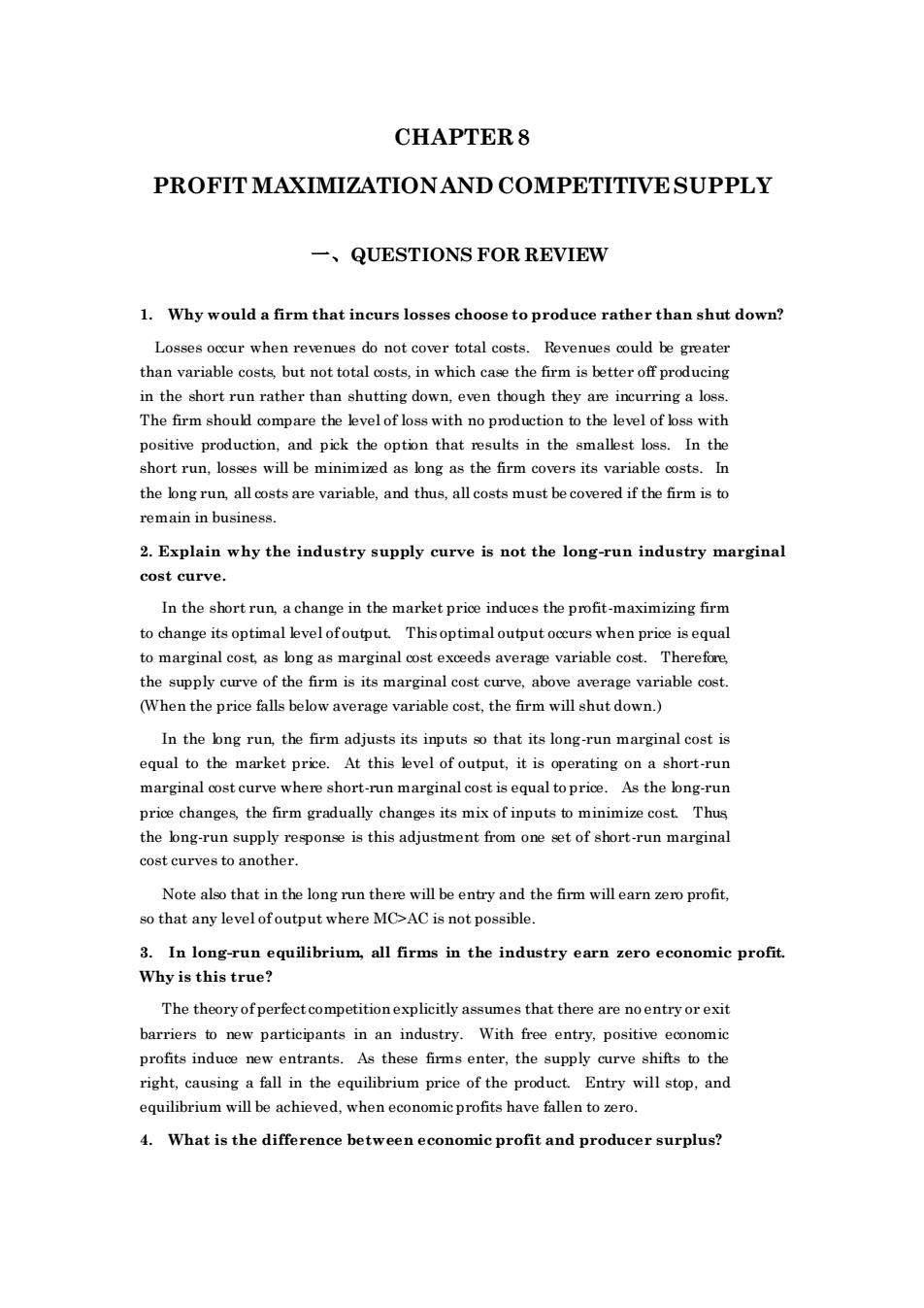正在加载图片...

CHAPTEr8 PROFIT MAXIMIZATIONAND COMPETITIVESUPPLY 一、QUESTIONS FOR REVIEW 1.Why would a firm that incurs losses choose to produce rather than shut down? Losses occur when revenues do not cover total costs.Revenues oould be greater than variable costs but not which the in the short run rather than shutting down,even though they are incurring a loss The firm should compare the level of loss with no production to the level of loss with positive production,and pick the option that results in the smallest loss.In the short run,losses will be minimized as long as the firm covers its variable costs.In the ngrun all ostsare variable,and thus,all costs must be covered if the firm is to min in busines 2.Explain why the industry supply curve is not the long-run industry marginal cost curve. In the short run a change in the market price induces the profit-maximizing firm to change its optimal kvel ofoutput Thisoptimal output occurs when price is equal to marginal cost,as long as marginal cost exceeds average variable cost.Therefore, variable cos In the the firm adjusts its inputsso that its longrun marginal cost is equal to the market prie.At this level of output,it is operating on a short-run marginal cost curve where short-run marginal cost is equal toprice.As the long-run price changes the firm gradually changes its mix of inputs to minimize cost.Thus the ng-run is this adjustment fromoofsort-run marginal eost curves to ar the Note also that in the long run there will be entrya nd the firm will earn zero profit so that any level ofoutput where MC>AC is not possible. 3.In long-run equilibrium,all firms in the industry earn zero economic profit Why is this true? The theory ofperfect competitionexplicitly assumes that there are noentry or exit barriers to new participants in an industry.With free entry,positive economic profits induce new entrants.As these firms enter,the supply curve shifts to the causing a fall in th price of the prod Entry will stop,and equilibrium will be achieved,when economic profits have fallen to zero. 4.What is the difference between economic profit and producer surplus? CHAPTER 8 PROFIT MAXIMIZATION AND COMPETITIVE SUPPLY 一、QUESTIONS FOR REVIEW 1. Why would a firm that incurs losses choose to produce rather than shut down? Losses occur when revenues do not cover total costs. Revenues could be greater than variable costs, but not total costs, in which case the firm is better off producing in the short run rather than shutting down, even though they are incurring a loss. The firm should compare the level of loss with no production to the level of loss with positive production, and pick the option that results in the smallest loss. In the short run, losses will be minimized as long as the firm covers its variable costs. In the long run, all costs are variable, and thus, all costs must be covered if the firm is to remain in business. 2. Explain why the industry supply curve is not the long-run industry marginal cost curve. In the short run, a change in the market price induces the profit-maximizing firm to change its optimal level of output. This optimal output occurs when price is equal to marginal cost, as long as marginal cost exceeds average variable cost. Therefore, the supply curve of the firm is its marginal cost curve, above average variable cost. (When the price falls below average variable cost, the firm will shut down.) In the long run, the firm adjusts its inputs so that its long-run marginal cost is equal to the market price. At this level of output, it is operating on a short-run marginal cost curve where short-run marginal cost is equal to price. As the long-run price changes, the firm gradually changes its mix of inputs to minimize cost. Thus, the long-run supply response is this adjustment from one set of short-run marginal cost curves to another. Note also that in the long run there will be entry and the firm will earn zero profit, so that any level of output where MC>AC is not possible. 3. In long-run equilibrium, all firms in the industry earn zero economic profit. Why is this true? The theory of perfect competition explicitly assumes that there are no entry or exit barriers to new participants in an industry. With free entry, positive economic profits induce new entrants. As these firms enter, the supply curve shifts to the right, causing a fall in the equilibrium price of the product. Entry will stop, and equilibrium will be achieved, when economic profits have fallen to zero. 4. What is the difference between economic profit and producer surplus?